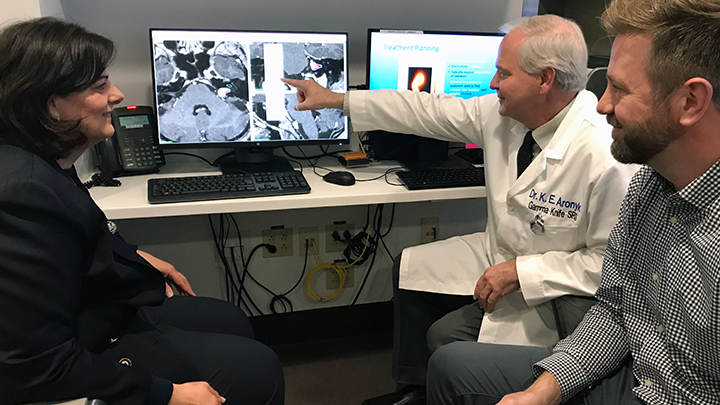
January 2, 2019

Dr. Keith Aronyk, centre, neurosurgeon and co-director of the Gamma Knife Unit at the University of Alberta Hospital, and Matt Larocque, medical physicist at the Cross Cancer Institute, show Mona Nashman-Smith, left, what her tumour looked like prior to her Gamma Knife treatment.
Story & photo by Sharman Hnatiuk
EDMONTON — For years, Mona Nashman-Smith suffered through debilitating headaches. But since receiving Gamma Knife radiosurgery a year ago at the University of Alberta Hospital (UAH) to treat a dime-sized benign brain tumour, she’s been headache-free and filled with abundant energy to work out at the gym and play with her three grandchildren.
For more than a decade, Nashman resisted having traditional brain surgery to remove her tumour, fearing its proximity to her facial nerve could leave her with nerve damage and hearing loss.
Unlike open surgery, Gamma Knife neurosurgery is non-invasive. It replaces a scalpel with beams of gamma rays that are guided with surgical precision, minimizing the impact on nearby healthy brain tissues.
“When I was offered the minimally invasive Gamma Knife treatment, I said yes immediately,” says Nashman, 61.
“My radiosurgery took place in the morning and I was able to walk out on my own that afternoon without any pain. I haven’t had a migraine since the treatment. For me, it is nothing short of a miracle.”
About 15 per cent of all patients requiring brain surgery at the UAH over the past year were able to undergo the painless, scalpel-free procedure in the facility’s state-of-the-art Gamma Knife suite.
To date, about 250 patients from across Alberta and western and northern Canada have benefited from the Scott & Brown Families Advanced Imaging and Gamma Knife Centre, which opened in December 2017.
Each Gamma Knife patient receives a tailored treatment plan developed by a team which includes a neurosurgeon, a radiation oncologist and a medical physicist. The plan is carried out with the support of radiologists, diagnostic imaging technologists, radiation therapists and nurses from the UAH and Cross Cancer Institute.
“We have patients with lesions or malformations in the brain that may have previously required open surgery and in-hospital stays — but now many patients are able to walk in for Gamma Knife treatment and be home the same day in time for dinner with their families,” says Dr. Keith Aronyk, neurosurgeon and co-director of the Gamma Knife Unit at the UAH.
Roughly half of the referrals in the Gamma Knife’s first year of operation have been for cancer patients in treatment at the Cross Cancer Institute for brain metastases, a cancer that’s travelled to the brain from elsewhere in the body.
“Gamma Knife treatment is a more precise alternative to whole brain radiation therapy for cancer that has travelled to the brain from elsewhere in the body,” adds Dr. Samir Patel, radiation oncologist and co-director of the Gamma Knife Unit.
“Access to Gamma Knife treatment has been a game changer for our care team and has dramatically improved the care our team can provide as well as the patient experience for many of our patients.”
Donors to the University Hospital Foundation’s Brain Centre Campaign fully funded the $17.2 million Scott & Brown Families Advanced Imaging and Gamma Knife Centre.